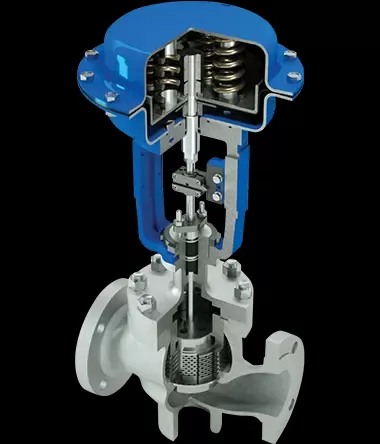Notifications

5 minutes, 43 seconds
-35 Views 0 Comments 0 Likes 0 Reviews

Pneumatic Globe Control Valves: An Overview
Pneumatic Globe Control Valves are crucial components in industrial systems that require precise regulation of fluid flow, pressure, and temperature. These valves utilize pneumatic actuators to adjust the valve's position based on control signals, enabling highly accurate fluid regulation. This article provides an overview of the working principles, components, and key considerations for selecting and maintaining Pneumatic Globe Control Valves.
Valve Body: The valve body is the core element that houses the internal components like the valve stem, disc, and seat. These components come into direct contact with the pressurized fluid. Globe valve bodies are often designed as two-port valves, with the inlet and outlet positioned in either opposing or angled arrangements.
Globe valves are well-suited for handling high-pressure, high-temperature, and aggressive fluids. To prevent issues like clogging or corrosion in horizontal pipelines, angle globe valves can be used for better fluid drainage when the valve is not in operation.
Pneumatic Actuator: Pneumatic actuators provide the mechanical force required to move the valve's internal parts. There are two main types of pneumatic actuators:
Piston Actuators: Compressed air moves the piston up or down, driving the valve stem.
Diaphragm Actuators: Pressure differences across a diaphragm create movement to adjust the valve's position.
Both actuator types enable precise control over the valve’s position, ensuring that fluid flow and system variables are accurately maintained.
Pneumatic Globe Control Valves operate by responding to control signals, usually from a process controller. The pneumatic actuator moves the valve’s internal mechanism, adjusting the valve's position to control fluid flow, pressure, or temperature according to the desired setpoints. This process uses compressed air as the power source, with feedback mechanisms continuously adjusting the valve's position to maintain optimal conditions.
When choosing a Pneumatic Globe Control Valve for a specific application, several factors should be considered:
Valve Body Material: The material affects the valve’s performance and longevity. Stainless steel is ideal for corrosive or high-temperature fluids, while cast iron can be used for more general applications.
Actuator Type:
Single-Acting: Best suited for emergency shut-off situations where rapid closure is needed.
Double-Acting: Ideal for applications requiring frequent valve operation and more consistent performance.
Application Parameters: Consider the flow range, operating temperature, and pressure ratings of the valve. These factors determine the valve’s ability to handle the system’s operating conditions effectively.
To ensure optimal performance, proper installation and maintenance of Pneumatic Globe Control Valves are essential:
Installation Tips:
Ensure proper alignment of the valve within the pipeline to prevent misalignment, which could lead to leakage or excessive wear.
Make sure the fluid flow direction matches the valve's markings to prevent poor performance.
Routine Maintenance:
Cleaning: Periodically clean the valve’s internal components to remove debris or contaminants that may obstruct movement.
Lubrication: Apply lubricant to the actuator’s moving parts to reduce friction and prolong the valve's lifespan.
Pneumatic Globe Control Valves, like all mechanical systems, can encounter issues. Here are common problems and potential solutions:
Actuator Failure: If the actuator isn't functioning correctly, check the air supply pressure and ensure the signal connections are properly configured. Low air pressure or faulty signal connections may cause actuator issues.
Leaking Valve: Inspect the valve seat and seals for signs of wear or damage. Replacing worn seals can help restore the valve's sealing performance.
Pneumatic Globe Control Valves are indispensable for maintaining precise control of fluid flow, pressure, and temperature in various industries. By understanding the components, working principles, and selecting the right valve for the application, companies can ensure reliable operation. Regular maintenance and proper installation are key to extending the lifespan of these valves and ensuring their continued effectiveness in demanding environments. Whether for general industrial use or specialized processes, Pneumatic Globe Control Valves provide the performance and precision necessary for optimal system operation.Know more about Google SEO Directory

